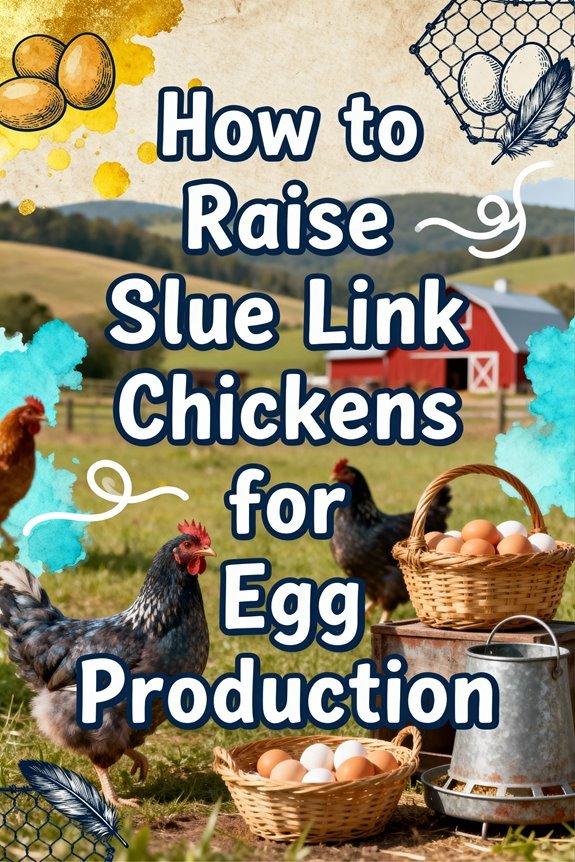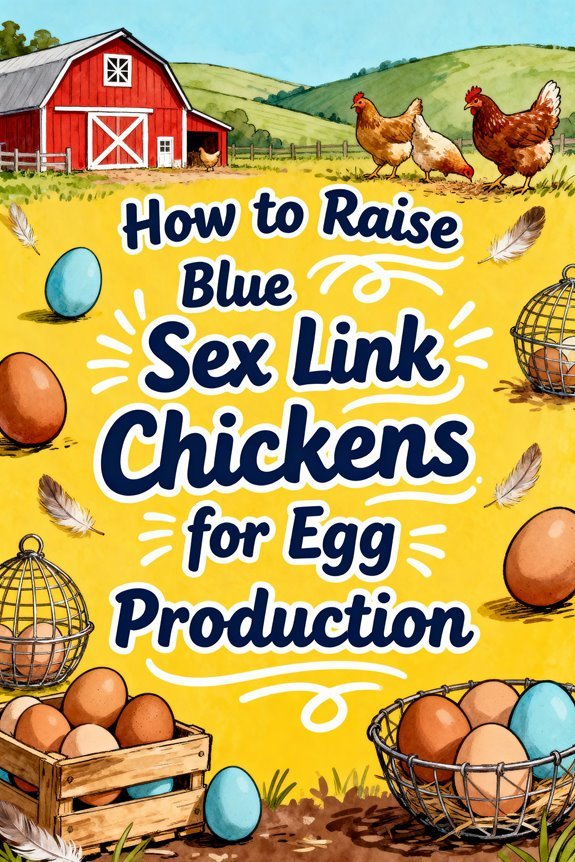How to Raise Blue Sex Link Chickens for Egg Production
To raise Blue Sex Link chickens successfully, you’ll need 3-4 square feet of coop space and 10 square feet of outdoor run per bird. Provide starter feed (20-24% protein) for chicks, shifting to layer feed (14-16%) at 18 weeks. Maintain 14-16 hours of daily light exposure and offer calcium supplements for ideal egg production. Keep the coop between 60-75°F with proper ventilation, and implement strict health monitoring protocols. Understanding additional management techniques can maximize your flock’s 300+ annual egg potential.
Understanding Blue Sex Link Breed Traits
While Blue Sex Link chickens are often mistaken for a pure breed, they’re actually hybrid birds created through specific crossbreeding. These chickens offer distinct hybrid advantages, including easy identification at hatching through their color variations. You’ll find that adult hens develop a solid blue plumage, while roosters display a characteristic blue barred pattern. Like their Red and Black Sex Link cousins, these birds showcase excellent hybrid vigor that enhances their hardiness in various climates.
You can expect these hybrids to lay green to dark green eggs consistently, making them valuable for diverse egg production. Their docile temperament makes them excellent additions to your existing flock. When planning your coop setup, allocate approximately 3 to 4 square feet per hen to ensure your Blue Sex Links remain comfortable and stress-free. Their calm and affectionate behavior parallels that of other popular backyard breeds, making them particularly suitable for families and first-time chicken keepers. When choosing Blue Sex Links for your coop, you’ll benefit from their predictable traits and reliable egg-laying capabilities. Understanding these fundamental characteristics will help you make informed decisions about incorporating these birds into your poultry operation.
Setting Up Your Chicken Coop and Run
Three essential components define a properly configured chicken coop and run for Blue Sex Links: adequate space, secure construction, and proper ventilation.
Your coop layout should provide 3-4 square feet per bird inside, with nesting boxes positioned two feet above ground level. Install one 12″x12″x12″ nesting box for every five hens, using wooden roosts to prevent frostbite. Maintain temperatures between 60-75°F through proper insulation and ventilation. These social birds require a minimum of three hens to maintain proper flock dynamics and wellbeing.
For run dimensions, allocate 10 square feet per bird outdoors. Secure the entire structure with 1/2-inch hardware cloth, buried 12-18 inches deep in an L-shape. Add shade areas and natural elements for foraging. Install multiple roosting bars and guarantee all doors have predator-proof locks. Regular perimeter inspections will maintain security against raccoons, hawks, and other predators. While rare, hens can develop rooster-like physical traits if their ovary becomes damaged, causing them to stop laying eggs and exhibit male characteristics such as crowing and comb development.
Essential Feeding and Nutrition Guidelines
Proper nutrition forms the cornerstone of raising healthy Blue Sex Link chickens, with specific dietary requirements changing as your birds progress through different life stages. Start your chicks on a high-protein starter feed (20-24%) for their first six weeks, then shift to a grower feed (16-20%) until week 18. After that, switch to layer feed containing 14-16% protein and increased calcium levels of 2.5-3.5%.
Establish consistent feeding schedules and monitor your birds’ protein sources carefully. You’ll need to provide additional calcium supplements during the laying period to support strong eggshell formation. Track your chickens’ growth and health regularly, watching for signs of nutritional deficiencies. When changing between feed types, implement gradual shifts over several days to prevent digestive issues. Provide free-choice access to complete layer feeds that meet nearly all nutrient needs, while keeping treats limited to no more than 15% of their total diet. Consider organic feed options for cleaner nutrition without synthetic additives, which can improve both chicken health and egg quality. Make sure your birds have constant access to fresh water, as chickens typically consume twice as much water as feed for optimal health and egg production.
Maximizing Egg Production Through Management
Beyond providing ideal nutrition, successful egg production from Blue Sex Link chickens depends on masterful management of environmental conditions and flock dynamics. Implement lighting strategies that provide 14-16 hours of consistent daily illumination, using artificial lights during shorter daylight months to maintain laying cycles. You’ll need to guarantee each hen has at least 4 square feet of space and access to nesting boxes, with one box per 4-5 birds. Monitor your flock’s productivity through detailed record-keeping, tracking egg numbers and shell quality. As production naturally declines after the first year, plan your flock rotation carefully to maintain prime output. Detailed documentation from successful breeders shows that some hens can achieve 247 consecutive laying days with proper care. Reduce stress by minimizing noise, avoiding overcrowding, and maintaining consistent daily routines. Provide environmental enrichments like dust baths to support natural behaviors and sustained laying performance. Supplementing their diet with nutritious vegetables like leafy greens, carrots, and pumpkin can enhance vitamin intake and overall wellness while keeping hens engaged. For optimal efficiency, focus on breeds with a high feed-to-egg conversion ratio, as this makes them more economical for both commercial operations and backyard setups.
Health Care and Disease Prevention
Maintaining robust health in Blue Sex Link chickens requires a detailed disease prevention strategy and vigilant monitoring. You’ll need to conduct daily health checks, looking for signs of illness, injury, or unusual behavior. Since sick chickens tend to hide their symptoms, daily observation becomes crucial for early detection. Implement a thorough disease management plan that includes regular coop cleaning, proper ventilation, and biosecurity measures like foot baths and visitor restrictions.
Focus your health monitoring efforts on common issues like respiratory problems, coccidiosis, and external parasites. Maintain strict vaccination schedules based on your veterinarian’s recommendations, and isolate new birds before introducing them to your flock. Provide a balanced diet with adequate protein and calcium, supplemented with immune-boosting additives like garlic or apple cider vinegar. Select feed based on your chickens’ specific life stage and nutritional requirements to support optimal health and egg production. Keep fresh water available at all times and guarantee your coop offers protection from extreme weather conditions. If you notice pecking injuries or bare spots on your birds, use anti-pecking sprays to promote healing and prevent further aggression from flock mates.
Selecting Quality Chicks From Hatcheries
Selecting healthy Blue Sex Link chicks begins with choosing a reputable hatchery that maintains strict breeding standards and documented health protocols. When evaluating hatcheries, focus on their breeding practices, NPIP certification, and vaccination programs, particularly for Marek’s disease. You’ll want to verify that the breeder uses proper parent stock combinations to ascertain accurate sex-linked characteristics.
Look for chicks that display the correct slate-blue to blue-gray plumage, indicating proper sex identification at hatch. They should be alert, vigorous, and free from respiratory issues or pasty butt. Order your chicks well in advance from hatcheries specializing in sex link crosses, and always request “sexed” females if egg production is your goal. These specialized hens can produce over 300 eggs annually during their peak laying years. Check the hatchery’s shipping policies and arrival guarantees before finalizing your purchase.
Common Challenges and Solutions in Raising Blue Sex Links
While raising Blue Sex Links can be rewarding, these hybrid chickens face several distinct challenges that require careful management. You’ll need to monitor for common health issues like coccidiosis and egg binding, which often emerge in overcrowded conditions. To prevent behavioral issues, guarantee each bird has adequate space and implement overcrowding solutions by maintaining proper coop dimensions.
Pay close attention to nutrition, particularly calcium and protein levels, to support their high egg production. You’ll want to provide crushed oyster shells and balanced feed to prevent problems like egg eating and weak shells. For laying hens, a layer feed with 15–18% protein and elevated calcium content is critical to ensure strong eggshells and support egg quality. Offering oyster shells through free-choice access allows hens to self-regulate their calcium intake according to their individual needs while preventing overconsumption by non-laying birds. Watch for signs of stress, including feather pecking and bullying, which you can address through proper ventilation, sufficient nesting boxes, and gradual introduction of new birds to the flock. These exceptional layers typically produce 300+ eggs annually, making them an efficient choice for egg production operations.




